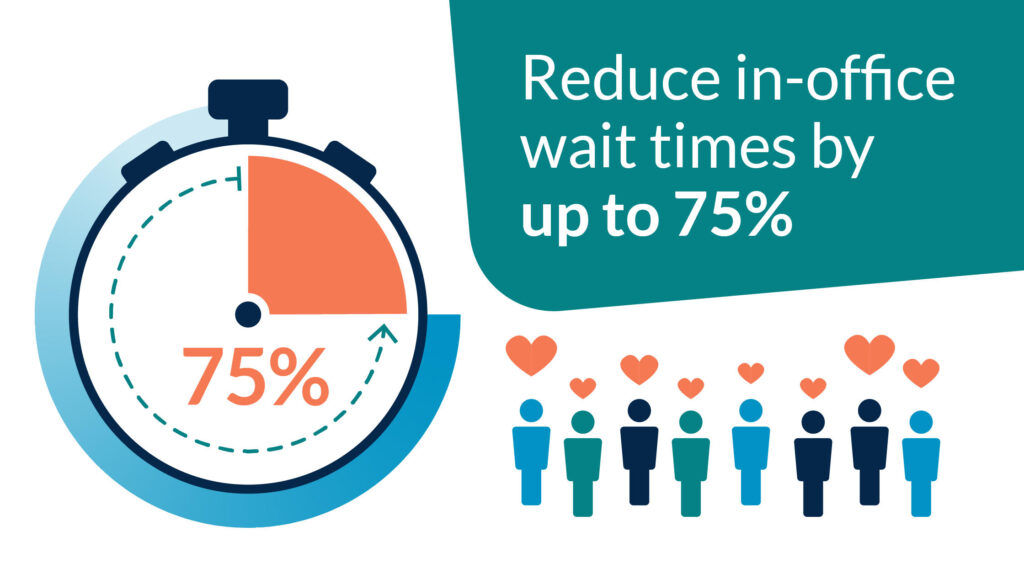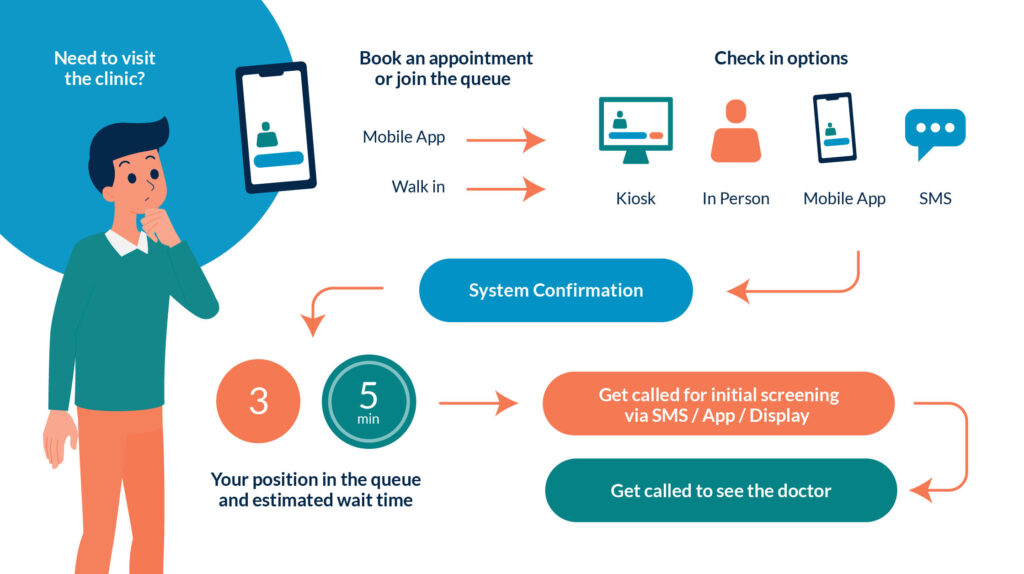A guide to patient queue management systems – how to deploy the best one.
Congratulations if you’ve come to this post searching for a patient queue management system; you’re embracing an efficient and customer-friendly approach to healthcare management.
- Keep reading for a complete guide that helps you choose and set up a system that suits your needs.
- Check out WaitWell’s healthcare page to see how we can best meet your organization’s needs.
- Get started and connect directly with WaitWell’s team for a demo or answers to your questions.
Table of contents
- Understanding Patient Queue Management Systems
- Benefits for both healthcare providers and patients
- Types of healthcare queue management systems
- Key Components
- Step-by-Step Deployment Guide for Patient Queue Management System
- A peek into the future patient queue management systems
Understanding Patient Queue Management Systems
The quality of care a patient receives includes their waiting room experience. So, no healthcare facility wants a crowded waiting room with long waits and disgruntled patients. However, everyone wants a booked-up schedule and efficient use of resources.
Many facilities are turning to queue management systems to help cut the chaos of traditional waiting rooms. Especially those struggling with coordinating walk-ins alongside appointments. An efficient queue management system means reduced waiting times, organized queues, streamlined patient flow, satisfied patients, and less stressed staff.
What are some of the important functionalities to look out for?
- Queue monitoring to help reception staff, doctors, nurses, and administrators monitor and manage patient queues in real-time, allowing for better resource allocation and improved overall workflow.
- Digital check-in functionality lets patients register their readiness for service digitally, reducing the need for manual paperwork and minimizing waiting times.
- Real-time patient updates about their appointments, reducing uncertainty and enhancing communication.
- Appointment scheduling allows patients to book appointments and helps healthcare providers manage their calendars and schedules effectively.
- Data analytics for the system to generate data on patient flow, enabling administrators to make informed decisions, optimize processes, and enhance overall efficiency.
- Mobile integration that enables patients to check in remotely, receive updates, and manage appointments from a phone app and/or via SMS
- Customization: A system that can be adapted seamlessly to various healthcare environments, such as hospitals, clinics, and diagnostic centers, catering to specific needs or use cases.
- Integration with Electronic Health Records (EHR): Seamlessly integrating with EHR systems allows efficient access to patient information and promotes a more coordinated approach to healthcare.
Benefits for both healthcare providers and patients
Healthcare providers
- Organization: An efficient patient queue management system leads to streamlined patient flow and reduced waiting times, creating a more efficient healthcare environment.
“We are no longer dealing with patients telling us that they arrived first or asking us how much longer they must wait,” says Agnie Machin, Clinic Manager at University Reproductive Associates.
- Time-saving: Automation of routine tasks and optimized resource allocation allows healthcare staff to focus on more critical aspects of patient care. As Agnie puts it:
“I have been working at this facility over 11 years, and I think this process has made it easier for the staff to check in patients while also continuing to work on other tasks,.
- Insights: Real-time analytics and queue monitoring enable effective allocation of resources, minimizing bottlenecks and improving overall resource utilization. Dr. Chan, a Physician at Immigration Medical Toronto, sums it up in a review of the WaitWell patient queue management system:
“I like that staff can see at a glance what room a patient is in, whether they have arrived or not, and if their COVID waiver has been completed.”
- Cost savings: The system’s efficiency and reduced administrative workload can lead to cost savings over time by optimizing resources, allocating staff based on real-time demand, and minimizing overstaffing and idle time.

Patients
- Efficiency: Digital check-ins and optimized scheduling reduce waiting times, enhancing the patient experience.
- Convenience: An efficient system that provides real-time updates and allows remote check-ins and mobile app notifications to inform patients about their appointments, reducing uncertainty and stress. Agnie Machin explains this practically:
“Patients check in via the QR code daily and know exactly what number they are in line and when they will be seen. It has solved the issue of patients constantly calling the office during our busiest hours to see how long the wait will be. Now they can simply send a text to join our line.”
- Enhanced care: A more organized and efficient healthcare process improves patients’ overall experience, satisfaction, and well-being.
Types of healthcare queue management systems
While there aren’t any standard types of queue management systems, here are some types we’ve encountered in the market based on primary functionality and features.
- Basic queue systems: Entry-level systems that manage patient queues through simple ticketing mechanisms. They provide a fundamental approach to managing and organizing patient flow, making them an accessible choice for healthcare facilities seeking basic queue management processes.
- Virtual queuing systems utilize digital platforms to allow patients to join a virtual queue without being physically in the waiting room.
- Self-Service kiosks: Enables patients to check in and update their information independently using self-service kiosks.
- Mobile app-based queue systems: With these, patients can check in, receive updates, and manage appointments through dedicated mobile applications.
- Specialized clinic queue systems: Tailored for specific healthcare settings, such as dental clinics, radiology centers, or specialty clinics, with features to meet unique requirements.
- Appointment scheduling software focuses on efficient appointment management, allowing patients to schedule, reschedule, or cancel appointments digitally.
- Multi-Location queue systems: Designed to manage patient queues efficiently across multiple locations or branches of a healthcare facility.
- Cloud-based queue systems: Utilizes cloud technology for accessibility, scalability, and ease of maintenance, allowing for efficient management of patient queues from anywhere.
- EHR Systems: Electronic health record systems with patient flow capabilities, such as appointment booking or queueing systems. For example, Epic Systems is an EHR that allows appointment scheduling.
- Comprehensive queue systems: Sophisticated queue management solutions that consolidate diverse functionalities from multiple systems. They provide a comprehensive and streamlined approach to patient flow and data management within healthcare settings. For example, WaitWell combines the features of various patient queue management systems, from virtual queues to appointment scheduling and self-service kiosks, and allows seamless integration with EHRs.
Unlike basic or specialized systems, comprehensive solutions, like WaitWell, consolidate various functionalities into a unified platform. This ensures seamless coordination across diverse aspects of healthcare operations, from virtual queues to appointment scheduling and self-service kiosks. The advantage lies in the ability to address a wide range of needs, streamline workflows, and provide a comprehensive solution that enhances both efficiency and patient satisfaction.
Key Components
Registration and check-in processes refer to the initial interaction between the patient and the system. It involves registering the patient’s details and the check-in process, which can be facilitated through self-service kiosks, mobile apps, SMS or help desk staff. Technical aspects may include user authentication, data input validation, and secure storage of patient information.
Real-time queue monitoring and updates: This component focuses on continuously monitoring the patient queue in real-time. It includes tracking each patient’s progress, updating their status, and notifying patients and staff about any changes or delays. Technical aspects may involve data synchronization, real-time communication protocols, and automated notification systems.
Integration with Electronic Health Records (EHR): This component involves seamless integration with Electronic Health Records (EHR) systems. It ensures that relevant patient information is readily accessible to healthcare providers during care. Technical considerations include interoperability standards, data mapping, and secure data exchange protocols.

Queue management flow with a comprehensive system
Step-by-Step Deployment Guide for Patient Queue Management Systems
You now understand what patient queue management might mean for your organization. The next challenge is figuring out what the process of deploying one should look like. The following steps, from assessment to post-configuration, should ensure a seamless deployment that sets your facility up for enhanced efficiency and patient satisfaction.
Assessing your facility’s needs
Before diving into the deployment process, conduct a thorough assessment of your facility’s specific requirements. Whether you operate a clinic, hospital, or diagnostics center, consider factors such as patient volume, existing workflows, and the desired level of integration with other systems, such as your Electronic Health Record (EHR) system.
Engaging stakeholders
The next crucial step involves engaging key stakeholders, including doctors, nurses, administrators, and IT personnel. Gather diverse perspectives on the facility’s needs to ensure a comprehensive understanding of the challenges and goals.
Defining objectives
Based on the assessment and stakeholder feedback, clearly outline the goals and objectives the PQMS aims to achieve. Whether it’s reducing waiting times, improving patient satisfaction, or optimizing resource allocation, a well-defined set of objectives will guide the entire deployment process.
Choosing the best patient queue management solution
Research and evaluation
Explore available patient queue management systems in the market, considering features, scalability, ease of integration, and vendor reputation. Ensure the selected solution aligns with your identified objectives and can adapt to future growth.
Customization options
Opt for a solution that can be tailored to your healthcare facility’s specific needs. Evaluate how well it integrates with existing systems and allows for seamless alignment with identified objectives.
Cost-benefit analysis
Conduct a comprehensive cost-benefit analysis, factoring in the initial investment, ongoing maintenance, and potential return on investment. Consider how the solution can improve efficiency and enhance patient satisfaction.
Installation and configuration process
Technical assessment
Before installation, assess your existing infrastructure for compatibility with the chosen solution. Consider hardware requirements, network capabilities, and data security measures.
Testing and quality assurance
Conduct thorough testing to identify and address any issues. Verify that the solution operates smoothly within the healthcare environment and meets the defined objectives.
Staff training and user adoption strategies
Training programs
Collaborate with your provider to train all staff members interacting with the solution. Provide comprehensive training for receptionists, healthcare providers, and administrators.
User-friendly documentation
Offer user-friendly resources to assist staff in understanding the system’s functionalities and troubleshooting common issues. Select a solution with robust customer support.
Promote user adoption
Implement strategies to encourage user adoption, such as incentives for online check-ins, feedback channels, and continuous support. Clear communication about the solution’s benefits is crucial for overcoming resistance to change.
Continuous improvement
Establish a framework for ongoing training and continuous improvement. Regularly gather feedback from staff to identify areas for enhancement and additional training needs.
Overcoming implementation challenges
Addressing resistance to change
Inform all stakeholders about the reasons behind PQMS implementation and emphasize its benefits to both staff and patients. Involve key stakeholders in the decision-making process to address concerns and encourage feedback.
Troubleshooting common issues
Prioritize thorough training programs to equip staff with the skills needed to navigate and troubleshoot common issues. Establish a dedicated support team or help desk for prompt issue resolution.
Regular updates and feedback loops
Implement a system for users to provide feedback and report issues. Regularly update the PQMS software to address bugs and enhance functionality based on user experiences.
A peek into the future of Patient Queue Management Systems
With technology rapidly and constantly evolving, patient queue management systems are also bound to get exciting upgrades. We are excited about these two:
AI and predictive analytics: The integration of Artificial Intelligence (AI) and predictive analytics is set to revolutionize patient queue management. AI algorithms can analyze historical data to predict patient flow, enabling proactive resource allocation and scheduling optimization.
Biometric authentication: Biometric authentication methods, including fingerprint or facial recognition, may replace traditional identification methods during the check-in process, adding an extra layer of security and efficiency.
Navigate with clarity: choose WaitWell
WaitWell is the solution to many challenges healthcare facilities face with patient queue management. With WaitWell:
- In-office waiting time is drastically reduced, up to 85%, leading to a more efficient healthcare environment.
- Up to 30% better patient retention resulting from streamlined processes that ensure higher patient satisfaction and increased loyalty.
- 50% less stress for staff from automating routine tasks. Staff can focus on critical aspects of patient care.
Join the ranks of medical practices experiencing the transformative power of WaitWell. Say goodbye to crowded waiting rooms, frustrated patients, and stressed-out staff. With WaitWell, it’s a win-win for both healthcare providers and patients—efficiency without sacrificing quality of care.







